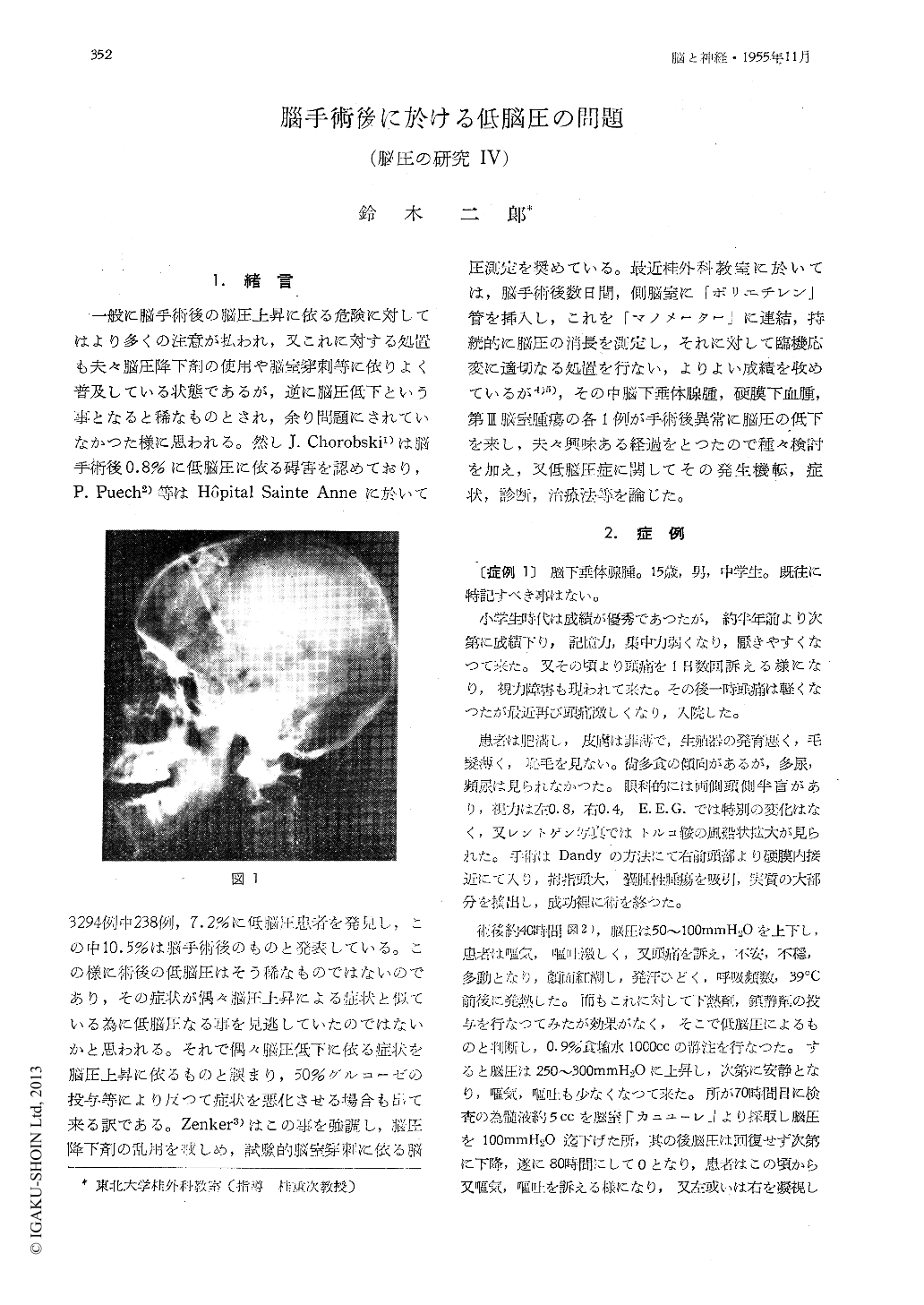- 有料閲覧
- 文献概要
- 1ページ目
1.緒言
一般に脳手術後の脳圧上昇に依る危険に対してはより多くの注意が払われ,又これに対する処置も夫々脳圧降下剤の使用や脳室穿刺等に依りよく普及している状態であるが,逆に脳圧低下という事となると稀なものとされ,余り問題にされていなかつた様に思われる。然しJ. Chorobski1)は脳手術後0.8%に低脳圧に依る碍害を認めており,P. Puech2)等はHôpital Sainte Anneに於いて3294例中238例,7.2%に低脳圧患者を発見し,この中10.5%は脳手術後のものと発表している。この様に術後の低脳圧はそう稀なものではないのであり,その症状が偶々脳圧上昇による症状と似ている為に低脳圧なる事を見逃していたのではないかと思われる。それで偶々脳圧低下に依る症状を脳圧上昇に依るものと誤まり,50%グルコーゼの投与等により反つて症状を悪化させる場合も出て来る訳である。Zenker3)はこの事を強調し,脳圧降下剤の乱用を戒しめ,試験的脳室穿刺に依る脳圧測定を奨めている。最近桂外科教室に於いては,脳手術後数日間,側脳室に「ポリエチレン」管を挿入し,これを「マノメーター」に連結,持続的に脳圧の消長を測定し,それに対して臨機応変に適切なる処置を行ない,よりよい成績を收めているが4)5),その中脳下垂体腺腫,硬膜下血腫,第III脳室腫瘍の各1例が手術後異常に脳圧の低下を来し,夫々興味ある経過をとつたので種々検討を加え,又低脳圧症に関してその発生機転,症状,診断,治療法等を論じた。
The increased intracranial pressure often follo-ws brain operations, and on the contrary the occurrence of intracranial hypotension after the operation is rare, but this condition is also of practical importance, because these symptoms resemble very muchthe state of intracranial hypertension. And when unrecognized and treated wrongly, it may cause an avoidable fatality.
In recent years, I have experienced 3 cases of intracranial hypotension, which followed the br-ain operation, identified by continuous measu-ring of pressure in cranium with using the apparatus which I had reported in this magazine.
Case I Hypophysial adenoma, aged 15 years, a male student.
The patient was operated by Dandy's method, and a cystic hypophysial adenoma as big as a thumb head was extirpated. While the intrac-ranial pressure showed from 50mmH2O to 100mmH2O for about thirty hours postoperati-vely, he developed symptoms of headache, nau-sea, vomiting. severe perspiration, tachycardia, tachypnea, hyperthermia (39℃), flashing of face and restlessness. But when the intracranial pre-ssure increased to about 300mmH2O by intrave-nous injection of 0.9% saline solution, these symptoms were reduced remarkably. After a while, the intracranial pressure decreased to 0mm H2O, when he lost his consciousness for about 1 minute without convulsion, which was repeated about ten times. However, by intravenous inject ion of 0.9% saline solusion, the intracranial pressure rised to about 200mmH2O, and the patient was released from the repetition of un-consciousness, and he elapsed eventless couse.
Case 2. Subdural hematoma, aged 50 years, a carpenter.
The pneumoventriculography was made by boring in the frontal region in face position. Dura mater was found to be depressed into cra-nium and had not pulsation and, though ventricular cannula was inserted into the lateral ventricle, cerebrospinal fluid did not flow out, and only about cc of cerebrospinal fluid could be obtained by aspiration. After the operation, he fell in general convulsion many times. The intracranial pressure was 0mmH2O, and it was only 100mmH2O even during convulsion. He was inunconsciousness, showed flasding of face, severe perspiration, and a great deal of sputum. a thousand cubic centimeter of 0.9% saline solution and a kind of barbiturate were injected intraveously, After that the intracranial pressure increased and he was released from convulsion and unconsciousness gradually. But in about 10 hour after the injection, the intracranial pres-sure often decreased to 0mmH2O. On the 4th day after the operation he was operatedby oste-oplastic craniotomy of the right frontpariet-occipital , region and a subdural hematoma 15cc in capacity and its capsule was extirpated. After the second operation he did not recover from intracranial hypotension and unconsciou- sness, inspite of the injection of 0.9% saline solu-tion. At last he died next morning.
Case 3. Tumor of third ventricle (Spongio. blastomapolare), aged 40 years, apoliceman. From the findindgs of pneumo-encephalogrgphy and the cerebellar symptom, Suspecting him of a cerebellar tumor was suspected, and the ope-ration was made by the suboccipital approach, but any tumor could not be found in the pos-terior fossa. After the operation, the intracranial pressure was kepting at 300mmH2O, but from about the 30th hour after the opetion the in-tracranial pressure began to decrease gradually and he developed symptoms of tachypnea, ta-chycardia, severe perspiration, peripheral cold-ness, flashing of face and hyperthermia. So 1000cc of 0.9% saline solution was injected and reinflation of the ventricle was done by the injection of saline solution to the ventricle several times, but these were not so effective and the intracranial pressure continued to decrease. His consciousness was in the state of lethargy to coma in spite of snjection and at last he died at the 75th hour after the operation.
Though the mechanism of intracranial hypo-tension had been discussed by some investigators, it may be thought that intracranial hypotension was chieflycaused by disappearence or insufficient secretion of cerebrospinal fluid which were caused by ischaemia and anoxaemia of hypothalamus, the disturbances of the hypothalamo-hypophysial connection, and collapse of ventricles or the removal of ventricles.

Copyright © 1955, Igaku-Shoin Ltd. All rights reserved.


